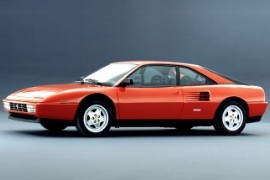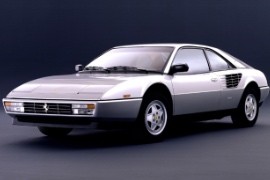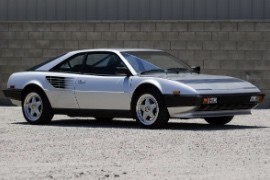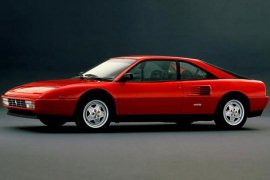FERRARI Mondial Models/Series Timeline, Specifications & Photos
First production year: 1980
Engines: Gasoline
Body style: Coupé (two-door)
Ferrari decided to keep the Mondial on the market for a few more years before retiring it, and for that, the Italian automaker decided to improve the model for the fourth and final time.
The aging Mondial started to show its age, but Ferrari was not yet ready to abandon the model. Even though many people considered that it was too old to be kept on the market, the economic situation was not so good, so the automaker played it wisely. It stayed on the safe side and invested just enough to keep the car attractive. After all, it sold in big numbers even after a decade on the market, even after the introduction of the 348 model in the lineup. But unlike its sibling, the Mondial T offered four seats and a suspension made for long travels.
When Pininfarina penned the Mondial’s shape in the ‘70s, the design studio did an excellent job, and it was difficult for the Italian automaker to improve the classic lines of the vehicle without spoiling its overall shape. As a result, there were minimal changes to the car’s exterior. Still, a keen eye for detail could notice the smaller air intakes mounted on the rear quarter panels and the wider fenders on both axles that had to cover the car’s wider track. In addition, the body-colored bumpers were now standard and sported black plastic molds on their lower side.
Inside, the leather-wrapped 2+2 cabin tried to provide enough comfort for adult-sized occupants. While that was true if all four people were just about average-sized, and even shorter ones seated in the back. The bolstered front seats were not very comfortable, and many people complained about them, while the rear ones didn’t provide enough headroom or legroom. The redesigned instrument cluster offered a much better, well-organized layout with two large dials for the speedometer and rev counter flanking two gauges stacked between them for the oil pressure and coolant temperature. On the outer sides, the automaker placed the fuel level on the left and the ammeter on the right. Between the front occupants, on the flat center console, Ferrari placed an array of buttons for several car functions, such as the HVAC controls, the power antenna, and the parking lights. In addition, the automaker placed the gated gear stick lever on the forward part of the center console. On the center stack, Ferrari added the buttons for the suspension settings, power windows, and stereo.
But the most significant change for the car was under the hood. There, the automaker reversed the engine and gearbox layout, placing the transmission in front of the V8 powerplant. As a result, the car’s weight distribution improved. Moreover, the engine gained a bigger displacement and produced 300 PS (296 hp) thanks to the advanced multi-point injection system. As a result, the Mondial T provided better road behavior and improved acceleration times. Last but not least, Ferrari developed, together with the European manufacturer Bilstein, new dampers that could provide a stiffer or a softer ride at the touch of a button.
When Pininfarina designed the Mondial, it did a great job, and the public appreciated the car from Detroit to Tokyo. In Europe, it was already an undisputed king of the fast four-seater.
In 1985, Ferrari gave its customers what they always asked: more power. The first generation of the Mondial struggled in 1980 with a 205 hp engine, and people didn't like it. There were family sedans with more power than that. In 1982, Ferrari introduced the four-valves per cylinder system that increased the power to 240 hp; close, but no cigar. Then, in 1985, it came with the real-deal: the 3.2-liter Mondial that offered 40 hp over the Mondial Quatrovalvole.
Fortunately, the facelifts didn't alter the car's look. It was still shaped sharp at the front with its pop-up headlights, and the grille in front of the rear wheels was already a Ferrari signature detail. The prancing-horse brand even bragged that it was an excellent vehicle for long journeys and it can carry some luggage with it.
Inside, Ferrari tried to make the 2+2 coupe suitable for four adult-sized occupants, but most of the Mondial's owners used it only for two in real life. That didn't stop the Italian carmaker to use expensive leather upholstery on all four seats and around the cabin. Ferrari used the same costly materials to clad the lower side of the dashboard as well.
To make room for a four-seat interior, Ferrari installed the engine in the back, on top of the rear axle. Between the 3.2-liter V-8 and the rear panel, the carmaker made room for a trunk, promising to keep your food warm on your way back from a drive-through!
While it wasn't the most successful model in Ferrari's lineup, the Mondial managed to stay on the assembly lines for more than a decade, from 1980 until 1993, in various versions.
The most successful version of the Mondial was introduced in 1982 and sported the name Quattrovalvole (four-valves). In those times, the four-valves per cylinder system was so new that only high-performance and some sporty premium vehicles were fitted with it. But the benefits that came with the system were obvious.
Ferrari chose to work with Pininfarina for the car's design, and it provided a tubular, space-frame chassis to the Italian coachmaker. That led to some problems of design limitations, which were gracefully passed by the young Pierangelo Andreani. At the front, the Mondial Quattrovalvole featured an unusual grille on the hood (which was actually the trunk). The pop-up headlights were a new trend in those times and made the cars look sleeker. In addition, the designer installed a pair of parking lights and blinkers on the front bumper and added a second grille on the apron. From its sides, the mid-engined car looked more like a sedan with a raked-forward rear windscreen, which was tilted at a sharper angle than the windshield. The side air intakes served to feed the engine with air, while at the back, the grilles were needed to let the hot air go out.
Inside, the Mondial featured a four-seat layout, even though there was hardly room enough for grown-ups on the rear bench. But that didn't stop Ferrari from creating a luxurious cabin, with leather on everything from the front bucket seats to the door cards and the dash panel. A chromed quattrovalvole badge was mounted in front of the side passenger.
Under the hood, the 3.0-liter V8 featured a dual-overhead-camshaft system. As a result, the engine produced 237 hp (240 PS), which was a respectable specific power for those times. Power went to the rear wheels via a five-speed manual gearbox.
Ferrari introduced the Mondial in 1980 as a grand tourer, with room for four and with the engine mounted transversely in the back, in a rear-mid position.
After retiring the 308 GT, the Italian automaker introduced the Mondial. A car made to provide comfort and speed over long distances. But unlike its predecessor, which was designed by Bertone, the Mondial was forged in the Pininfarina studios by Pierangelo Andreani, with some later input from Leonardo Fioravanti. But the small studio didn't have the resources to build the bodywork so that task was handed over to the coachbuilder from Carozzeria Scaglietti.
The car featured a clean design, with pop-up headlights and a grille laid on the front trunk lid. The cabin started with a raked windshield and a longer roof than a regular two-seat sportscar. While the cabin ended abruptly with a vertical rear windscreen, its wide C-pillars gave the idea that it was a sloped-down shape. And yet it wasn't due to the engine cover, which had to open. At the back, the Mondial received a set of four round taillights.
Ferrari installed a leather-wrapped interior for the Mondial, with bolstered front seats separated by a center console that housed the gear stick. In the back, there was room for two adults in individual chairs with bolstered areas. The dashboard looked chunky with its squared and tall instrument cluster, but it followed those years' design principles. Nevertheless, it was easy to read and featured all the essential engine data on several gauges and two large dials.
While the Mondial 8 was not the most successful version of this nameplate, it provided a certain level of comfort and performance. But, after two years, the automaker withdrew it anyway and replaced it with the four-valves version of the same 2.9-liter V8.



